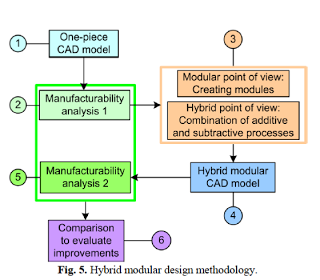Design For Manufacturing (DFM) approaches aim to integrate manufacturability aspects during the design stage. Most of DFM approaches usually consider only one manufacturing process, but products competitiveness may be improved by designing hybrid modular products, in which products are seen as 3-D puzzles with modules realized aside by the best manufacturing process and further gathered. A new DFM system is created in order to give quantitative information during the product design stage of which modules will benefit in being machined and which ones will advantageously be realized by an additive process (such as Selective Laser Sintering or laser deposition). A methodology for a manufacturability evaluation in case of a subtractive or an additive manufacturing process is developed and implemented in a CAD software. Tests are carried out on industrial products from automotive industry.
In order to stay competitive in the modern mass production industry, products have to be designed and manufactured with the following opposing goals: decreasing time and cost; improving quality and flexibility. One way to improve product competitiveness is the Design For Manufacturing (DFM) approach. DFM involves simultaneously considering design goals and manufacturing constraints in order to identify manufacturing problems while parts are being designed; thereby reducing the lead time for product development and improving product quality. Most of the DFM systems do not have the ability to handle multiple processes, and concentrate only on one specific manufacturing process. This paper aims to bring a new DFM approach to multi-process manufacturing.
Nowadays, technical improvements in additive manufacturing processes provide the opportunity to manufacture real functional metal parts]. In fact, rapid manufacturing supersedes rapid prototyping because the additive technology, such as Selective Laser Sintering (SLS), is no longer exclusively used for prototyping. Furthermore, new fabrication possibilities are offered by machines that are able to depose and fuse metal powder directly on machined blocks. These additive manufacturing processes provide an interesting alternative to High-Speed Machining (HSM). Difficult – or even impossible – to machine parts (such as very complex shapes and conformal cooling channels in injection dies) may be manufactured by an additive process in preference to a costly and time consuming electro-discharge machining process. The problem is the characterization of the manufacturing complexity at the design stage in order to choose the most appropriate process.
This paper presents a new hybrid modular design methodology. Starting from one-piece CAD model, global and local manufacturability indexes are calculated. In the case of local indexes, which provide a well-detailed view of which areas of the part are the most difficult to manufacture, the manufacturability analysis is based on octree decomposition. This new approach enables us to focus on the areas of the part that are the most difficult to manufacture because an accurate view of the manufacturing difficulties distribution is obtained. Then, hybrid and modular points of view help designers to choose between a one-piece design and a hybrid modular one.
This method has been developed as a new DFM system in CAD software. It is one of the first attempts to expand the DFM concept to a multi-process situation, combining additive processes (such as SLS or powder projection) to more traditional subtractive ones (HSM) in a hybrid modular vision. Two industrial examples taken from the field of tooling have been treated to illustrate the possibilities of this new methodology, and the way it can be used in an industrial manner.
Further research will be conducted to optimize the methodology and to define new manufacturability indexes. In this paper, indexes are based on geometric parameters. It is important to bring into play indexes that can be calculated directly at the design stage. Parameters that require a complete manufacturing preparation analysis (for example: cutting tool path strategy) are not taken into account, so as not to depend on manufacturer’s skills. To have a more detailed view of manufacturing complexity, more accurate manufacturability indexes may be calculated, with other parameters involved, based on material information and technical specifications. A study has to be carried out in order to be able to compare different indexes between each other. The way the assembly constraints modify the design of the modules has also to be integrated in the methodology because all the modules must be carefully gathered in order to create a whole part with same level of quality as a one-piece part.
If you liked this article, please give it a quick review on ycombinator or StumbleUpon. Thanks

Brian Wang is a Futurist Thought Leader and a popular Science blogger with 1 million readers per month. His blog Nextbigfuture.com is ranked #1 Science News Blog. It covers many disruptive technology and trends including Space, Robotics, Artificial Intelligence, Medicine, Anti-aging Biotechnology, and Nanotechnology.
Known for identifying cutting edge technologies, he is currently a Co-Founder of a startup and fundraiser for high potential early-stage companies. He is the Head of Research for Allocations for deep technology investments and an Angel Investor at Space Angels.
A frequent speaker at corporations, he has been a TEDx speaker, a Singularity University speaker and guest at numerous interviews for radio and podcasts. He is open to public speaking and advising engagements.



